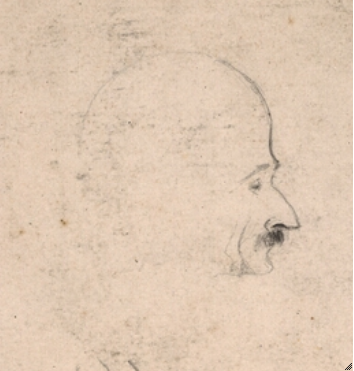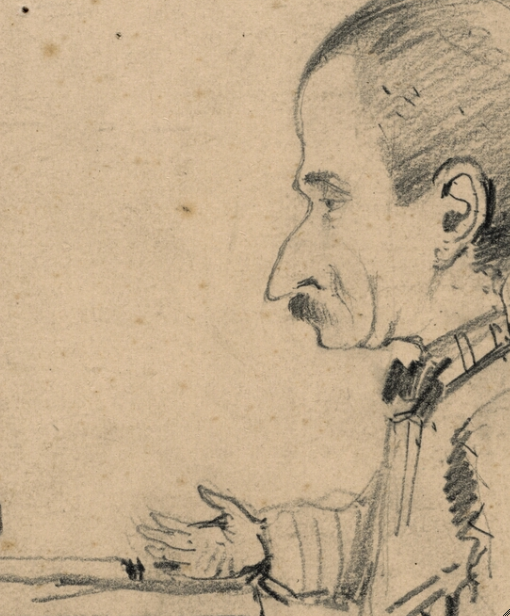Cat. 7
Caricature of a Man Standing by a Desk
1855/56
Graphite on commercially prepared ivory wove card (discolored to tan); 203 × 166 mm
The Art Institute of Chicago, Mr. and Mrs. Carter H. Harrison Collection, 1933.894r
Sketch of a Male Head in Profile
1855/56
Graphite on commercially prepared ivory wove card; 202 × 165 mm
The Art Institute of Chicago, Mr. and Mrs. Carter H. Harrison Collection, 1933.894v
Technical Report
Technical Summary
Claude Monet created Caricature of a Man Standing by a Desk with [glossary:graphite] on a slightly textured ivory [glossary:wove] card. From the layout of the composition it appears that he worked out the figure with light, quick strokes of graphite, followed by darker, broader lines to more fully establish the form. Horizontal and diagonal lines were selectively used to create shadows in the body of the figure and darker values in the hair and pants. Monet added several dots of graphite throughout the drawing, particularly in the head of the figure. It is unclear whether this was intentional.
Signature
Claude Monet (recto, center top edge, in graphite).
Media and Support
Support Characteristics
Primary paper type
Ivory (discolored to tan), very thick, slightly textured wove card.
Furnish
Uniform with few fiber inclusions.
Formation
Even.
Other characteristics
The corners are all rounded.
Dimensions
203 × 166 mm
Preparatory Layers
No artistic surface alterations or coatings are visible in normal conditions, under [glossary:UV] illumination, or under magnification. Under UV illumination, there is a pale-yellow visible-light [glossary:fluorescence] overall on the paper surface that is characteristic of a light gelatin surface [glossary:sizing].
Media Characteristics
The composition was drawn using the fine point of a soft graphite to establish the profile of the figure’s face. Tonal effects were created using the side of the graphite in a back-and-forth motion. The point of the graphite was then used to further define the figure’s outline and to establish details. There are many small dots throughout the figure’s head and body and the desk. It appears that Monet jabbed the graphite into the [glossary:support] in quick, up-and-down movements to create these dots. This type of application of the graphite creates a unique line similar to an engraving line, the bluntness of which tapers at the end. It is unclear whether this was the artist’s intention or an inadvertent application of media. The desk and the vessels on it were minimally modeled using the side of the graphite to create both broad, thick linear marks and faint, back-and-forth strokes. There is minor smudging near areas of dense application of media. This appears to be offset rather than a result of the artist intentionally smudging the graphite to create tone.
On the verso there is a faint profile of a man’s face in graphite (fig. 7.1). It appears to be very similar to the drawing of the man on the recto.
Compositional Development
The composition was drawn directly onto the paper support. There is minor reworking on the figure’s forehead and the proper right hand and sleeve (fig. 7.2).
Surface Treatment
No fixatives or coatings are visible in normal conditions, under UV illumination, or under magnification.
Condition History
The drawing is in very good condition. There is a moderate accumulation of surface soiling and discoloration overall. There are many faint brown [glossary:foxing] spots throughout the card. With UV-induced visible fluorescence, the foxing spots on the recto fluoresce yellow. There are two light-brown water-type stains near the top corners. The edges of the card have lifting paper fibers along with minor fiber abrasions. There are several pinholes throughout the card. One pinhole is located at the center of the top edge along with a pinhole that pierced the verso but did not puncture the other side. One of the pinholes penetrates the tip of the M in the signature. The pinholes near the upper left corner and near the center of the right edge have rust deposits inside the holes. There are two small dents approximately 37 mm from the upper edge and 36 mm from the right edge. Another two similar type dents are located at the lower right corner, approximately 37 mm from the bottom and right edges. The left edge has a small dent at each corner, approximately 35 mm from the top and bottom edges and 35 mm in from the left edge. Dents at the fours corners perhaps indicate the artist’s method of holding down the card while he was drawing. There is a small cluster of dents near the base of the neck. Gray areas at the bottom corners are excess adhesive. There is a small area of paper abrasion at the bottom left corner. On the verso, there is a faint accumulation of surface dirt, and the edges of the paper support are moderately discolored. There are a few golden-yellow foxing spots throughout the card. With UV-induced visible fluorescence, the foxing spots on the verso fluoresce white. Along all edges residual water-soluble adhesive and remnants of green paper are visible. There are several old, white paper hinges at the four corners and at the center of the left and right edges.
Dawn Jaros
Provenance
Alfred Dusseuil (1878–1927), Paris.
Sold by Henri Cottereau, Paris, to Carter H. Harrison (1860–1953), Chicago, winter 1927–28.
Given by Carter H. Harrison to the Art Institute of Chicago, 1933.
Selected References
Hugh Edwards, “The Caricatures of Claude Monet,” Bulletin of the Art Institute of Chicago 37, 1 (Jan. 1943), p. 71.
Charles Merrill Mount, Monet, a Biography (Simon & Schuster, 1966), p. 396.
Daniel Wildenstein, Claude Monet (Fratelli Fabbri, 1971), p. 92, no. 49 (ill.).
Rodolphe Walter, “Claude Monet as a Caricaturist: A Clandestine Apprenticeship,” trans. Eric Young, Apollo 103 (June 1976), p. 489.
Harold Joachim and Sandra Haller Olsen, French Drawings and Sketchbooks of the Nineteenth Century, vol. 2 (University of Chicago Press, 1979), p. 70, no. 4A12.
Daniel Wildenstein, Claude Monet: Catalogue raisonné, vol. 5, Supplément aux peintures: Dessins; Pastels; Index (Wildenstein Institute, 1991), p. 145, no. D497 (ill.).
Other Documentation
Inscriptions and Distinguishing Marks
Recto
Inscription
Location: center bottom edge
Method: graphite
Content: Parbleu Si J’ai Connu Sousse!!!
Verso
Signature
Location: lower right corner
Method: purple colored pencil
Content: Claude Monet
Inscription
Location: center
Method: graphite
Content: [Jordn?]
Mark
Location: center left edge, encircled and surmounted by a checkmark
Method: graphite
Content: 32
Stamp
Location: center
Method: brown ink
Content: The Art / Institute of / Chicago
Mark
Location: lower left edge
Method: graphite
Content: 33.894
Examination Conditions and Technical Analysis
Raking Visible Light
Paper support characteristics identified.
Transmitted Visible Light
Paper mold characteristics identified.
Ultraviolet-Induced Visible Fluorescence (365 nm)
Pale-yellow fluorescence observed throughout; several foxing spots fluoresce white.
Binocular Microscopy (80–100×)
Media type/application identified.
Image Inventory
The image inventory compiles records of all known images of the artwork on file in the Imaging Department and in the conservation and curatorial files in the Department of Prints and Drawings at the Art Institute of Chicago (fig. 7.3, fig. 7.4).




